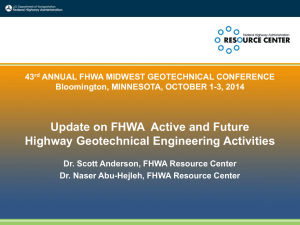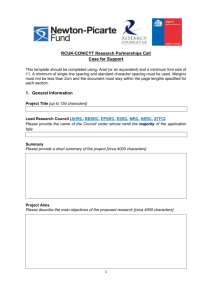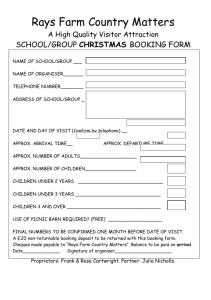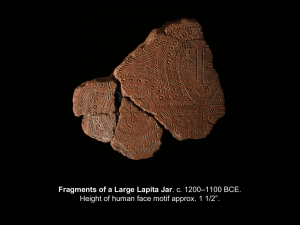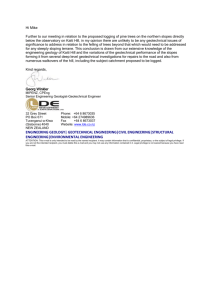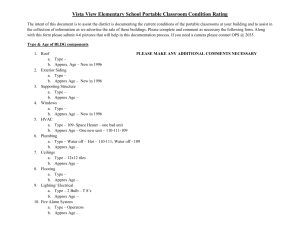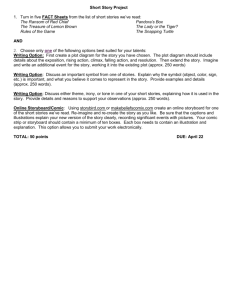HOW TO SPECIFY ANCHOR VERTICA®
advertisement
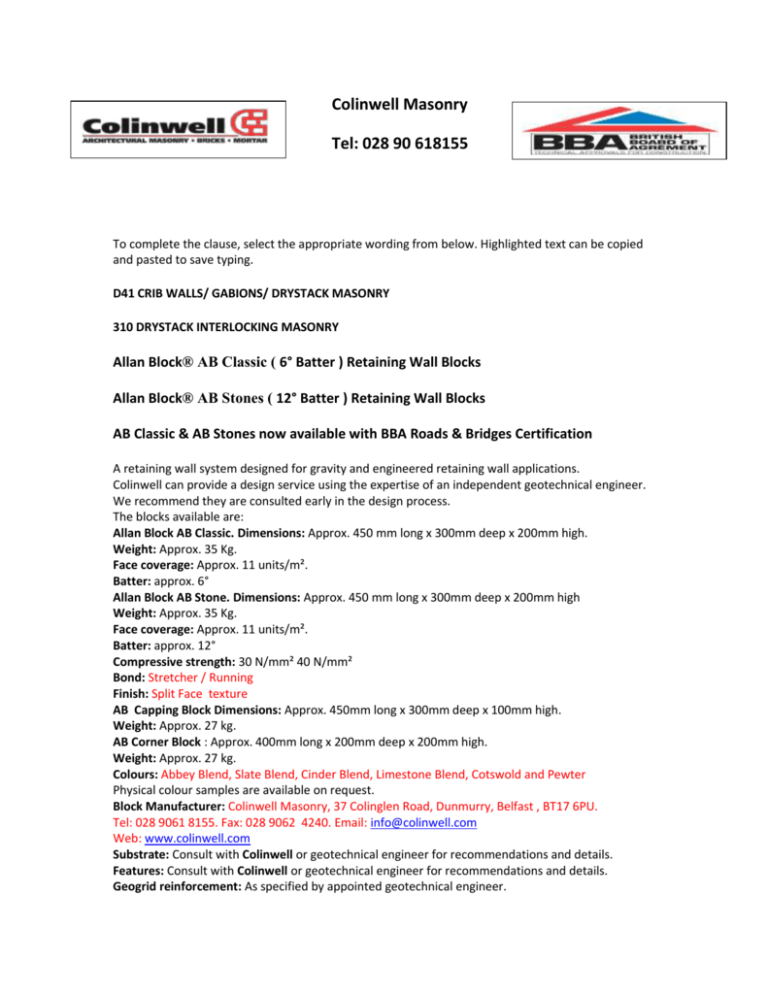
Colinwell Masonry Tel: 028 90 618155 To complete the clause, select the appropriate wording from below. Highlighted text can be copied and pasted to save typing. D41 CRIB WALLS/ GABIONS/ DRYSTACK MASONRY 310 DRYSTACK INTERLOCKING MASONRY Allan Block® AB Classic ( 6° Batter ) Retaining Wall Blocks Allan Block® AB Stones ( 12° Batter ) Retaining Wall Blocks AB Classic & AB Stones now available with BBA Roads & Bridges Certification A retaining wall system designed for gravity and engineered retaining wall applications. Colinwell can provide a design service using the expertise of an independent geotechnical engineer. We recommend they are consulted early in the design process. The blocks available are: Allan Block AB Classic. Dimensions: Approx. 450 mm long x 300mm deep x 200mm high. Weight: Approx. 35 Kg. Face coverage: Approx. 11 units/m². Batter: approx. 6° Allan Block AB Stone. Dimensions: Approx. 450 mm long x 300mm deep x 200mm high Weight: Approx. 35 Kg. Face coverage: Approx. 11 units/m². Batter: approx. 12° Compressive strength: 30 N/mm² 40 N/mm² Bond: Stretcher / Running Finish: Split Face texture AB Capping Block Dimensions: Approx. 450mm long x 300mm deep x 100mm high. Weight: Approx. 27 kg. AB Corner Block : Approx. 400mm long x 200mm deep x 200mm high. Weight: Approx. 27 kg. Colours: Abbey Blend, Slate Blend, Cinder Blend, Limestone Blend, Cotswold and Pewter Physical colour samples are available on request. Block Manufacturer: Colinwell Masonry, 37 Colinglen Road, Dunmurry, Belfast , BT17 6PU. Tel: 028 9061 8155. Fax: 028 9062 4240. Email: info@colinwell.com Web: www.colinwell.com Substrate: Consult with Colinwell or geotechnical engineer for recommendations and details. Features: Consult with Colinwell or geotechnical engineer for recommendations and details. Geogrid reinforcement: As specified by appointed geotechnical engineer. Backfill: Consult with appointed geotechnical engineer for recommendations and details. Design parameters: Consult with appointed geotechnical engineer for recommendations and details. Assembly/Installation: As clause 320 320 LAYING DRYSTACK INTERLOCKING MASONRY Gravity Wall Construction Site Prep and Excavation • Remove surface vegetation and organic soils. • Per the approved plan, excavate base trench a minimum of 600 m wide and 300 mm deep. • Remove unsuitable soils and replace with compactable materials. • Buried block should be a minimum of 150 mm. Check plans to see how much buried block is required. • Compact and level trench. Step 2: Install Base Material • Per the approved plans, place a minimum of 150 mm of compactable aggregate in the base trench and rake smooth. • Compact and level base material. Step 3: Install Base Course • Begin at the lowest wall elevation. Place AB units on base material, check and adjust for level and alignment of each unit. • Drain pipe is required for walls over 1.2 m tall or are constructed in silty or clay soils. See approved plans for location and specifications. Step 4: Install Wall infill aggregate and Backfill Materials • Fill the AB hollow cores and a minimum of 300 mm behind the wall with compactable aggregate. • Use approved soils to backfill behind the wall rock and in front of the base course. • Use a plate compactor to consolidate the area behind the block. Compact in lifts of 200 mm or less. Step 5: Install Additional Courses • Remove all excess material from the top surface of AB units. This can be done when installing the next course of block, by sliding the block into place. • Stack the next course of blocks so that the vertical seams are offset from the blocks below by at least 75 mm or 1/4 the length of the block. • Check and adjust for level, alignment and the wall batter as the wall stacks up. • Fill the block cores and behind with compactable aggregate. • From course 2 and above use a plate compactor to compact directly on the blocks as well as the area behind the blocks. Compact in lifts of 200 mm or less. • Use 200 mm of impermeable fill on the last lift to finish off wall. Reinforced Wall Construction Step 1: Site Prep and Excavation Foundation soils at the bottom of the base trench must be firm and solid. If the soils are made up of heavy clay or wet soils, or the areas have been previously excavated, remove entire material and replace with granular aggregate base, compacting 200 mm lifts or less. • Remove all surface vegetation and organic soils. This material should not be used as backfill. • Excavate behind the wall to accommodate the design length of the geogrid. Refer to the approved plans for exact length. • Excavate base trench at the wall location. Dig the trench, per the approved plans, a minimum of 600 mm wide and 150 mm deep plus the required amount to accommodate the buried block. • Buried block should be a minimum of 100 mm or 25 mm for each 300 mm of wall height. See approved plans for exact amount needed. Step 2: Install Base Material The base material can be any compactable granular material. Allan Block recommends a well-graded aggregate, with a balanced mix of grain sizes, ranging from 16 mm to 40 mm diameter. • Per the approved plans, place drain pipe at the back of the trench the length of the wall. The drain pipe will need to be vented to daylight or to a storm sewer system. See approved plans for location and specifications. • Per the approved plan, place a minimum of 150 mm of base material in the base trench and rake smooth. • Compact with a mechanical plate compactor. • Check the entire length for level, and adjust as needed. 330 GEOGRID REINFORCEMENT Colinwell can recommend a geotechnical design specialist. If such a specialist is required they should be consulted early in the design process.

